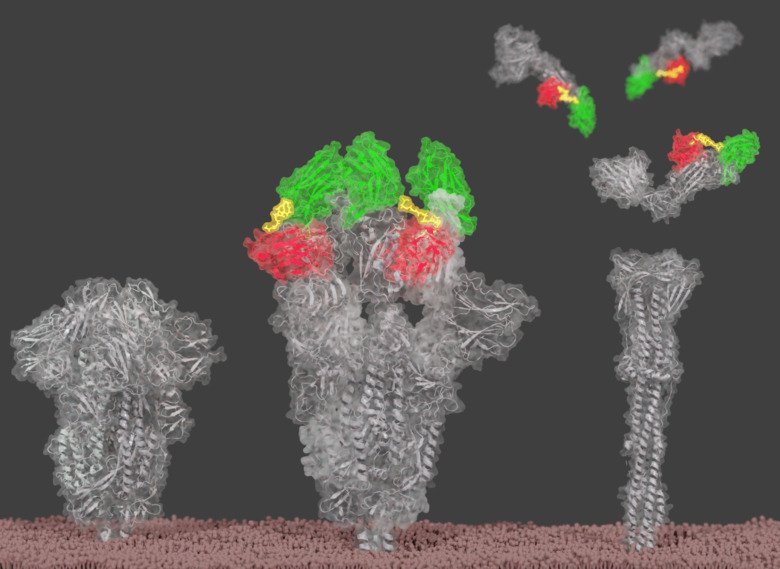New small antibodies show promising effects against COVID-19 infection

Researchers at Karolinska Institutet have developed, in collaboration with researchers in Germany and the U.S., new small antibodies, also known as nanobodies, which prevent the SARS-CoV-2 coronavirus from entering human cells. The research study, published in Science, shows that a combined nanobody had a particularly good effect – even if the virus mutated. According to the researchers, the nanobodies have the potential to be developed into a treatment for COVID-19.
Specific proteins, spike proteins, on the surface of the SARS-CoV-2 coronavirus help the virus infect host cells. Therefore, antibodies that block the spike proteins and prevent them from binding to the cell can be a way to stop infection.
From the perspective of potential therapeutic interventions, small fragments of antibodies, referred to as single-domain antibodies (sdAb) or nanobodies, may be a better alternative than regular antibodies. That is because nanobodies are significantly smaller. They are therefore able to bind to the virus in more places than regular antibodies. Nanobodies also have greater stability and are easier to produce cost-effectively on a large scale.
The SARS-CoV-2 infection

Researchers at Karolinska Institutet are now publishing, in collaboration with researchers at the University of Bonn in Germany and the Scripps Research Institute in California, a study describing new nanobodies against SARS-CoV-2 infection.
“What is uniquely special here is that we have stitched together nanobodies that bind to two different places on the spike protein of the virus,” explains Martin Hällberg, researcher at the Department of Cell and Molecular Biology at Karolinska Institutet, and one of the research study’s corresponding authors. “This combination variant binds better than individual nanobodies and is exceptionally effective in blocking the virus’ ability to spread between human cells in cell culture.”
Additionally, the combined nano-antibodies worked even when tested on a virus variant that mutates extremely quickly.
“This means that the risk is very small that the virus would become resistant to these combined nanobodies,” notes Martin Hällberg.
To generate the nanobodies, alpacas and llamas – animals whose immune systems naturally produce both antibodies and nanobodies – were vaccinated with the spike protein of the coronavirus. Among the nanobodies generated by the animals, the researchers selected the best binders. Among these, four were identified as showing an exceptional ability to block the virus’ ability to spread among human cultured cells.
Antibodies neutralise viruses
The research group at Karolinska Institutet then used electron cryomicroscopy (cryo-EM) to study in detail how the various nanobodies bind to the virus’ spike protein. Thanks to their structural knowledge, they were able to propose suitable protein links to bind different nanobodies together into combinations relevant for research, as well as provide a possible explanation for the mechanism of how the antibodies neutralise the virus.
“My ‘favourite’ is the nanobody from the llama,” Martin Hällberg says. “It binds directly over the surface where the virus binds the host cell receptor ACE2, and the nanobody also shares a large majority of the amino acids critical for binding with ACE2. What this means is that the virus will have an extremely difficult time mutating extensively on that surface and at the same time being able to bind ACE2. A variant where this llama antibody is linked to one of the antibodies from alpaca was a fox trap that the virus never managed to get out of in our experiments.”
The researchers now hope that their nanobodies will be able to be developed into a drug treatment as a complement to a vaccination against COVID-19.
“It possibly could be used clinically for those already ill, or for prevention for individuals who for one reason or another cannot be vaccinated, or who have a weakened immune system, and therefore may not form a sufficiently strong immune response after a vaccination,” explains Martin Hällberg.
Further studies on the way
Dioscure Therapeutics, a spin-off company from the University of Bonn, will be conducting further testing of the nanobodies in clinical trials. The researchers at Karolinska Institutet will make attempts to improve the binding further by changing individual building blocks in the nanobodies.
The research was funded by the Swedish Research Council and the Knut and Alice Wallenberg Foundation, as well as by research funders in Germany and the U.S.
The researchers behind the research study have filed patent applications associated with the nanobodies. Two of the researchers are also co-founders and shareholders in the company Dioscure Therapeutics, which will be commercialising the antibodies. Two of the researchers have connections with each other, as co-founders, consultants and shareholders in the IFM Therapeutics company.
Publication
”Structure-guided multivalent nanobodies block SARS-CoV-2 infection and suppress mutational escape”, Paul-Albert König, Hrishikesh Das, Hejun Liu, Beate M. Kümmerer, Florian N. Gohr, Lea-Marie Jenster, Yonas M. Tesfamariam, Lisa D.J. Schiffelers, Miki Uchima, Jennifer D. Wuerth, Karl Gatterdam, Natalia Ruetalo, Maria H. Christensen, Caroline I. Fandrey, Sabine Normann, Steffen Pritzl, Jan M. P. Tödtmann, Leo Hanke, Jannik Boos, Meng Yuan, Xueyong Zhu, Jonathan Leo Schmid-Burgk, Hiroki Kato, Michael Schindler, Ian A. Wilson, Matthias Geyer, Kerstin U. Ludwig, B. Martin Hällberg, Nicholas C. Wu and Florian I. Schmidt. Science, online January 12, 2021, doi: 10.1126/science.abe6230.
